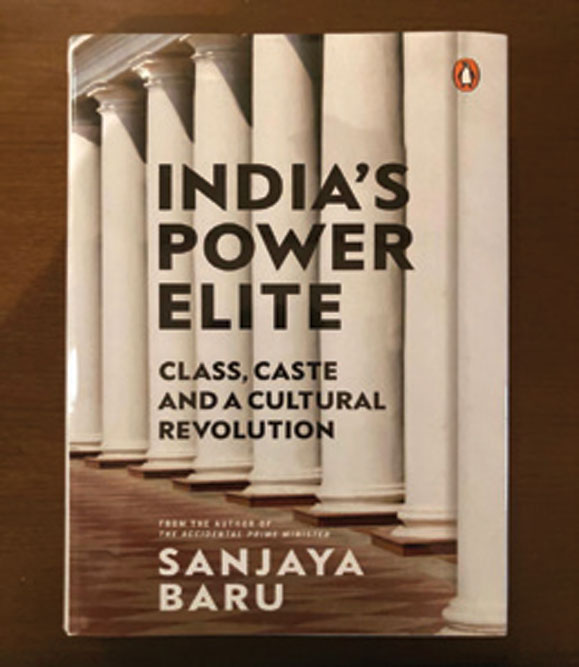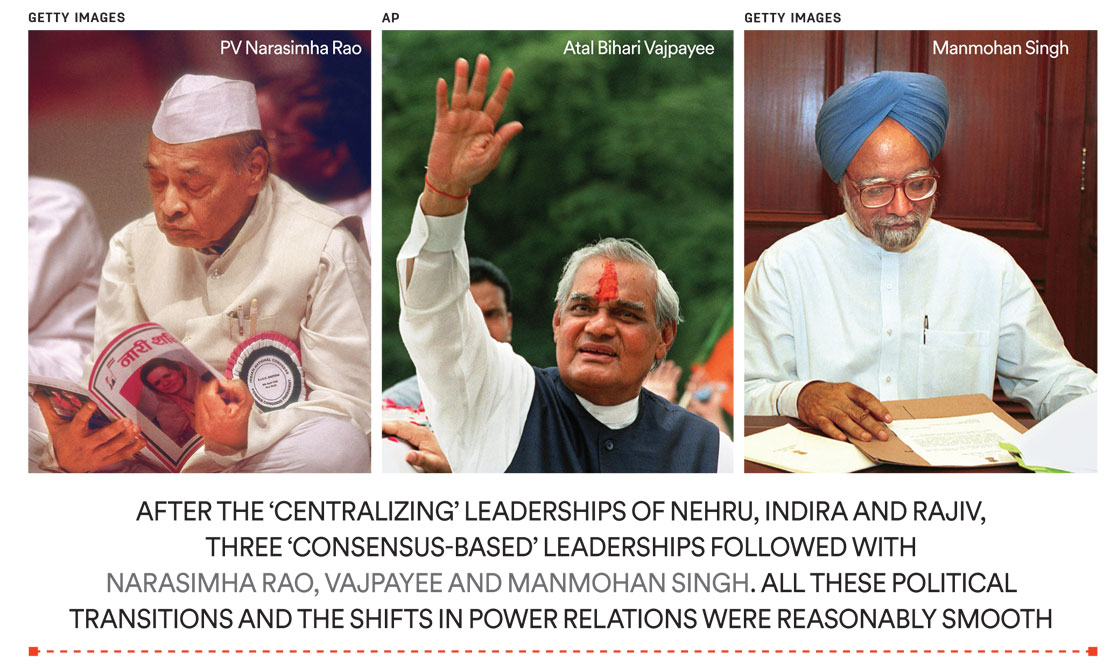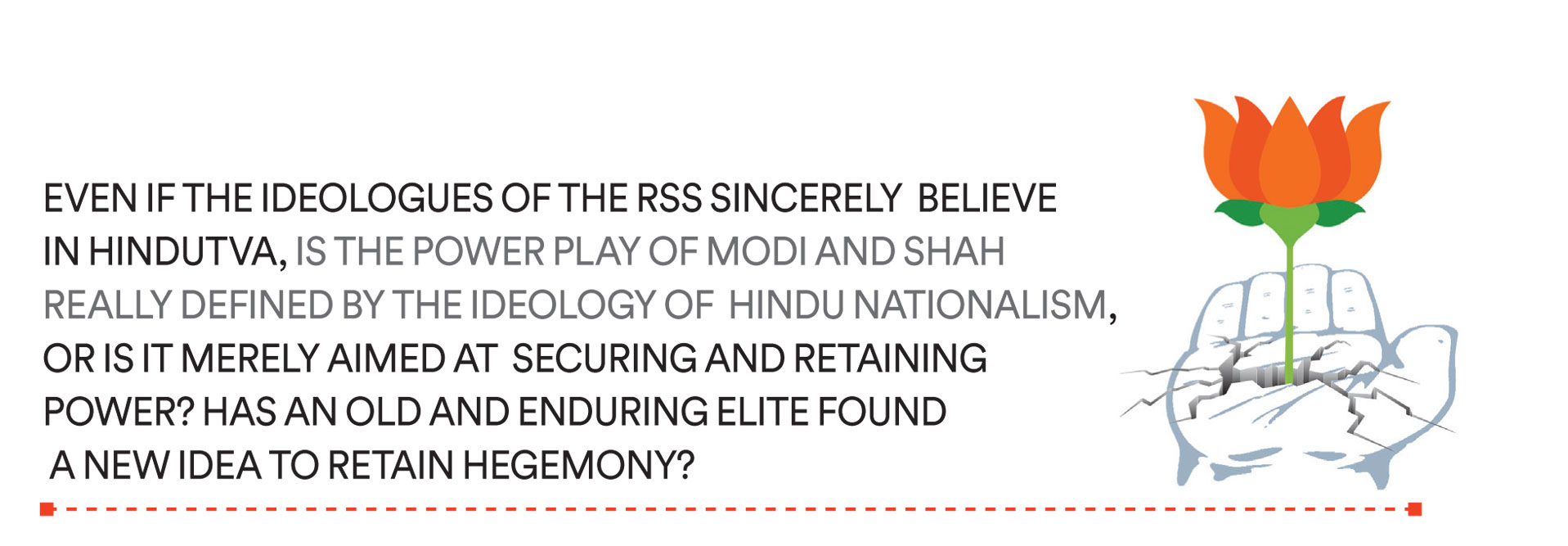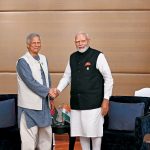The New Establishment
The assertion of Hindutva and the disintegration of the Nehruvian order
 Sanjaya Baru
Sanjaya Baru
 Sanjaya Baru
Sanjaya Baru
 |
09 Apr, 2021
|
09 Apr, 2021

/wp-content/uploads/2021/04/NewEstablishment1.jpg)
(Illustration: Saurabh Singh)
THE SMOOTHNESS OF the transfer of power in British India and from most Indian kingdoms to the new Indian state enabled the elites of pre-Independence India to continue to enjoy much of the power they had even in the new republic. While the Constitution bestowed new rights on the hitherto repressed and downtrodden, the balance of social, political and economic power remained with the traditional elites—the upper castes, the landed gentry and the emerging business class. The INC became the umbrella party of the business, the peasantry and the middle classes, with the communists and socialists rallying whatever opposition there was to the left of the Congress. A feeble attempt was made to build a right-wing opposition, in the form of the Swatantra Party, but intra-elite differences led to its quiet decline, with G.D. Birla telling his business colleagues, ‘Swatantra politics are not good businessmen’s politics.’
The real alternative to the Congress came from regions and castes that jostled for greater space within the ‘Congress System’—Dravidian mobilization in Tamil Nadu challenged not just the dominance of the Tamil upper castes but of the Hindi-speaking north-Indian-dominated Congress. In Uttar Pradesh—Nehru’s own home turf and the epicentre of Congress power—the party’s secular decline began with the departure of the Jats, under Charan Singh’s leadership, then the Yadavs, under Mulayam Singh’s, and, finally, the Dalits and Muslims, under Mayawati. Once Brahmins and Kayasthas had also crossed over to the BJP, the Congress was left with Raebareli and Amethi, the Nehru family’s pocket boroughs. The rise of the Communist Party in Bengal, Kerala and Andhra Pradesh had a touch of regionalism, with language and culture playing a big part in mass mobilization. By the 1980s, the decline of the Congress was largely on account of the rise of regional and caste-based political parties. Walking out of the large Congress umbrella, its voters splintered, gathering under many foldable ones.
The decline of the Congress in a large number of states also meant that the regional elite shifted their loyalties to regional parties. In Bengal, Marwari businessmen began to get used to Jyoti Basu’s leadership, just as the Brahmins and Chettiars of Tamil Nadu learnt to live with Dravidian leadership. In UP, Dalit leader Mayawati managed to win over Brahmins. Losing its support among a rising regional elite, a shrinking Congress depended increasingly on the support of big business and the Lutyens’ elite.
The end of the Congress era was followed by an ‘era of coalitions’ whose caste, class and regional composition varied over the years. After the ‘centralizing’ leaderships of Nehru, Indira and Rajiv, three ‘consensus-based’ leaderships followed with Narasimha Rao, Vajpayee and Manmohan Singh. All these political transitions and the shifts in power relations were reasonably smooth. Barring the aberration of the Emergency, the democratic process proceeded smoothly even as democratic institutions became weaker. The political power elite corrupted and captured all the institutions of the state—the bureaucracy, the police, the judiciary and the media. Aborted land reforms preserved landlord power, tariff protection and the Licence-Permit-Control Raj sustained monopolies and public expenditure, and subsidies kept the middle class happy.

Despite all these shortcomings, the economy performed reasonably well. The average annual rate of growth of national income rose from 3.5 per cent during 1950-80 to 5.5 per cent in 1980-2000 and 7.5 per cent thereafter. A rising economy created wealth that was shared unequally across regions, castes and classes, further empowering the elite. Those still dissatisfied with the pace of change and extent of opportunity emigrated. Through this era of rising economic growth, the Congress failed to remobilize itself and re-emerge as the dominant national party, nor was the left able to enter the space vacated by the Congress. Rather, regional and caste-based parties, on the one hand, and the ‘Hindu-Hindi’ BJP, on the other, occupied the Congress space.
The BJP had the option of becoming a Congress-like umbrella party, seeking allies among regional parties. That was the path Vajpayee chose to take. His defeat in 2004 was taken as proof of failure of such an enterprise. The RSS and the BJP hardliners opted for Hindu majoritarianism. Once the BJP secured a majority of its own in Parliament and across several states, it chose to implement its Hindutva manifesto. What made this shift possible was the fact that a growing aspirational middle class from an increasingly urbanizing India was ready to accept the BJP’s Hindutva agenda in the name of nationalism. The BJP then secured agrarian support, adopting a strategy first tried by Indira Gandhi in the 1970s, of turning the terms of trade between industry and agriculture in the latter’s favour. It then made a distinction between small and medium business and big business, winning both of them over with different policy instruments. With time, [Narendra] Modi has succeeded in ensuring that the power elite that constituted the foundation of Congress power would now bolster BJP’s.
The BJP targets every institution that the Congress had managed to bend to do its bidding, now including non-government organizations and the ‘new media’, creating an intrusive state that many view as the thin end of an authoritarian one. If Indira Gandhi sought a ‘committed civil service’, so does Narendra Modi. The police and other paramilitary forces, the investigative agencies and the intelligence apparatus have long learnt to kneel when asked to bend by the political masters of the day. In seeking an accommodative judiciary, the BJP is once again learning from Indira’s Emergency precedent. Be it crony capitalists, media barons or the leadership of the armed forces, every member of the power elite accommodates itself to the new power dispensation.

IF THERE IS a difference between the old ‘Congress System’ and the new BJP system, it lies in the latter’s ideology-driven power politics. The Congress thrived as an all-inclusive party adopting and adapting political platforms with the sole purpose of securing power. It remained committed to pluralism, but its commitment to values such as secularism and socialism was contingent upon their political benefits. The BJP, under Modi, also seeks power and all the perks of power, but it has an overriding commitment to the ideology of Hindu majoritarianism. Unveiling the statue of Swami Vivekananda on JNU campus, in November 2020, Modi did say ‘One thing that has done great harm to the democratic system of our country is to give priority to ideology over national interest.’ However, it was not clear if he was only referring to the ideologies of the left and liberal, that the BJP has campaigned against, or if his message was also aimed at his own party’s bigoted ideologues.
Even as the BJP tries to build a wider national base with Hindutva, it has to contend with the interests of a regional power elite. While a weak left has not been able to mobilize on the basis of class, powerful regional leaders have been able to use caste and language as buffers to ward off the challenge of Hindu consolidation. It is in dealing with all these complexities that Modi has used his anti-elitism, attacking ‘Lutyens’ Delhi’, to consolidate the BJP’s hold. For how long, remains to be seen. It will depend critically on how the economy performs over the remainder of his term, for that is what matters to every segment of the people and the power elite.

The elite in a multilayered, multidimensional society like India’s would of course not be a homogenous group either in social composition or cultural outlook. Unlike many societies of the West and the East, India is defined by its plurality and diversity. Even Hinduism is defined by its plurality. Diversity and plurality of experience is inherent to a civilizational nation of continental proportions. However, all societies are hierarchical and power relations are defined by these social, cultural and economic hierarchies. What makes India different, if at all, is the multiplicity of its hierarchies. Caste, class, language, region, ethnicity and even the colour of skin define the hierarchies of power. Even Dalits—scheduled castes in the Constitution—now argue on who among them has benefited more from affirmative action. Many, not all, of these hierarchical structures have endured despite significant social, political and economic change within the framework of a democracy. Caste certainly has, even if attitudes and even equations are changing. While class endures despite half a century of democratic socialism, language remains an important marker of power and elitism.
The sources and use of power differ between rural and urban India and across different regions of India. Given the diversity of Indian social structure, one can identify a ‘regional’ elite, a ‘national’ elite and a ‘globalized’ elite, each with different caste composition and different cultural practices, social values and even economic capabilities. Thus, it is possible to suggest that the morphology of the power elite outlined here may not fully capture the complexity of the Indian reality. Unlike countries that have experienced social revolutions or military occupation that have in turn had a lasting impact on social relations, upsetting existing hierarchies and creating new ones, India’s ‘gradual revolution’ has ensured that long-standing social hierarchies have endured. New layers of social and cultural practice rest uneasily on old ones. The transition from a colonial and feudal past to a democratic and republican present has not obliterated these old hierarchies. The big business and the big landlords of the pre-Independence period continue to be the wealthy of today, even if new groups have entered their ranks. Within this overall structure of continuity in power relations there has also been some change.
Radical social revolutions disrupt, destroy and rebuild. Gradual and consensual change, as we see in India, reshapes and reconfigures. In each epoch a nation’s social, political and economic elite tries to control change, preserving its privilege and power, by promoting a grand idea that it is capable of defining and deploying to ensure its dominance. The British Empire was run on that principle. A small minority of aliens operated a vast empire by asserting the hegemony of an idea that the majority came to accept. After securing Independence, the builders of the republic wrote a Constitution that enabled the nation’s power elite to remain in positions of economic privilege, while granting equality of constitutional status to all. The ideas were new and in consonance with the times—democracy, equality, socialism, secularism—but their implementation was such as to preserve existing relations of power and privilege.

Over the years, new ideas have been deployed to perpetuate old hierarchies while managing change at the margin. The constitutional derecognition of untouchability and reservations for the scheduled castes and tribes has wrought major social changes, yet it has not altered the basic structure of power and the nature of elitism defined by caste as an institution. Similarly, all manner of welfare schemes and social protection have empowered workers, but the class relations between owners of capital and the owners of labour power endure. The spread of education has empowered new social groups, and yet access to education remains a privilege.
DEMOCRATIC SOCIALISM AND state-funded development ensured political stability during what has come to be known as the Nehruvian era. When that process ran out of steam, technological change and economic liberalization unleashed pent-up energies in the rural and urban economies, fuelling a new phase of development. The Green Revolution in agriculture, in the 1970s, and trade and industrial policy liberalization, in the 1980s and 1990s, increased incomes and empowered new social classes, providing the social context for the new turn in Indian economic and foreign policy after 1991.
The post-Nehruvian paradigm, 1991 to 2014, has also run its course. If the Nehruvian era created and sustained its own power elite, so did the post-Nehruvian era. Across fields of business, culture, media and politics, new caste and social groups rose to social dominance and acquired political power. The names among the top twenty business groups in the year 2000 were significantly different from the top twenty of 1980.
Political parties and leaders unheard of in 1980 had become national players by 2000. The big guns of the 1970s media had fallen silent by the end of the century while new brands and banners had come to dominate. It was a period of significant change, yet the basic principles of the republic enshrined in the Constitution had not yet been questioned.
That paradigm, too, is beginning to shift. A significant majority no longer swears either by ‘socialism’ or ‘secularism’. Prime Minister Modi’s rise to political dominance is now increasingly viewed as the beginning of a second republic, if not a third. The assertion of Hindutva in politics, society and culture and the pursuit of an ‘Atmanirbhar Bharat’ is said to define a ‘New India’. How deep and enduring this change will be remains to be seen, but it is already reshaping the hierarchy of power and the notion of elites and elitism.
Is BJP really turning India into a Hindu nation, or is the focus on religion a tactic used by the politically and economically powerful elite to hide their failure in ensuring sustained and equitable economic growth and development for all? Is the Hindutva assertion a moment of awakening of a dormant people, or an attempt to prevent that awakening by an elite intent on retaining political power, even as the poor bear the brunt of poverty, ignorance and disease?
All populist ideologies blunt the rough edges of reality. Be it Maoism during the Chinese Cultural Revolution and Xi Jinping Thought today, Islamic radicalism in the highly unequal West Asian feudal kingdoms and in a military-dominated Pakistan, or Trump’s call for a White-dominated America, ideological movements of various kinds—some secular, some religious—appear to be ways in which an old elite seek to retain power, unable to deliver on their promise of development and justice.
Even if the ideologues of the RSS sincerely believe in Hindutva, is the power play of Modi and [Amit] Shah really defined by the ideology of Hindu nationalism, or is it merely aimed at securing and retaining power? How then is the BJP’s Hindutva any different from Indira Gandhi’s socialism and secularism, whose aim was merely to capture and retain power, reshaping a social reality with the hope of perpetuating not just individual power but the power of the social classes that support the leader? Has an old and enduring elite found a new idea to retain hegemony?
If wealth and power is all that the power elite seek, ideology becomes nothing more than a veil. Beneath the surface of rising communal consciousness, long-enduring inequalities and inequities remain, and the power elite seek to retain their privileges in the face of the challenge these pose. Even as a new cultural nationalism seeks to unite a diverse society, it also has the effect of papering over enduring social and economic divisions. The success of the democratic experiment has been that it has managed to ensure political and social stability despite economic inequality. The elite are often frustrated by the gradual pace of change and those who feel alienated have successfully seceded, either leaving the country or retreating into enclaves that have been created to prevent the dualism of a ‘Bharat and India’ from destabilizing the republic. One must recognize that it is this very gradualism of change that has not just ensured political and social stability, but also the perpetuation of the social and economic foundations on which the elite have constructed their powers and privileges.
Many years ago a development administrator familiar with the ground reality of change in a traditional society suggested that those who seek rapid and speedy change do not quite appreciate the fact that Indians are quite amenable to gradual change as long as that change is in a positive direction for their own families and for themselves. Contemporary India may envy China’s high rates of growth and rapid transformation; however, that order of change can destabilize an inherently unequal society seeking to function within a democratic system. Gradualness of change and empowerment has the advantage of not drawing attention to the extremes of inequality and the concentration of wealth and power that rapid growth entails, as it has in so many fast-growing economies. The power of the Indian elite has endured because, notwithstanding the vulgarity of wealth, the corruption of politics, the prejudices of casteism and communalism and the secession of the successful, a vast majority has come to accept the gradualness of change in their own lives. Their acquiescence in this gradualness contributes to the resilience of the power elite.
(This is an edited excerpt from India’s Power Elite: Class, Caste and a Cultural Revolution (Viking; 264 pages; Rs 699) by Sanjaya Baru)

/wp-content/uploads/2025/06/Cover-OpenMinds2025.jpg)










More Columns
Puri Marks Sixth Major Stampede of The Year Open
Under the sunlit skies, in the city of Copernicus Sabin Iqbal
EC uploads Bihar’s 2003 electoral roll to ease document submission Open